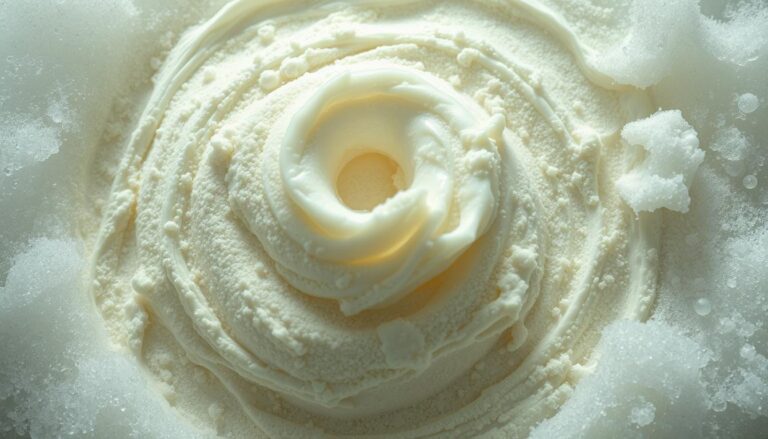How Can I Keep My Teeth Clean Between Dental Visits?
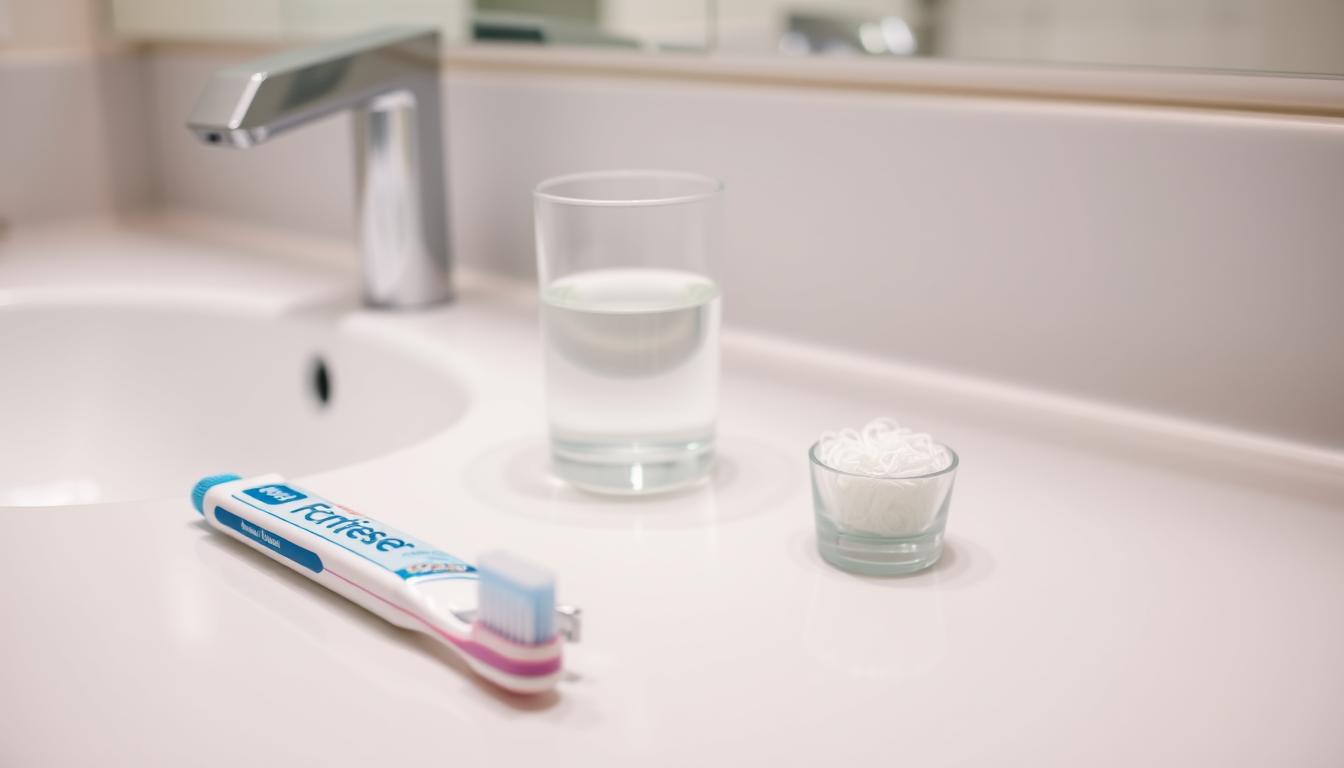
Did you know the average American brushes their teeth for 38.5 days in their life? Keeping your teeth clean at home is a great way to stay healthy. Yet, it’s easy to miss simple steps that keep our mouths healthy between dental visits. With the right tips and tools, anyone can keep their mouth clean and healthy.
Wondering how to keep your teeth clean between dental visits? It starts with daily habits and knowing how your choices can affect your teeth. Learning how to brush properly, picking the right dental care products, and eating healthy are key for your teeth’s health. While visiting the dentist is important, taking care of your teeth every day is just as vital for a healthy mouth.
Key Takeaways
- Understanding the significance of daily at-home dental care practices to maintain oral hygiene.
- Recognizing that individual commitment to oral health is as vital as professional dental visits.
- Incorporating effective brushing and flossing techniques as part of a daily regimen.
- Acknowledging the impact of dietary choices on dental health and hygiene.
- Realizing the importance of staying hydrated and how it contributes to a clean mouth.
- Using the correct at-home dental tools to complement professional care and enhance oral cleanliness.
The Importance of Oral Hygiene
Strong oral hygiene is key for good oral health. It includes dental hygiene, care, and preventive dentistry. These steps boost well-being and lower the risk of oral diseases.
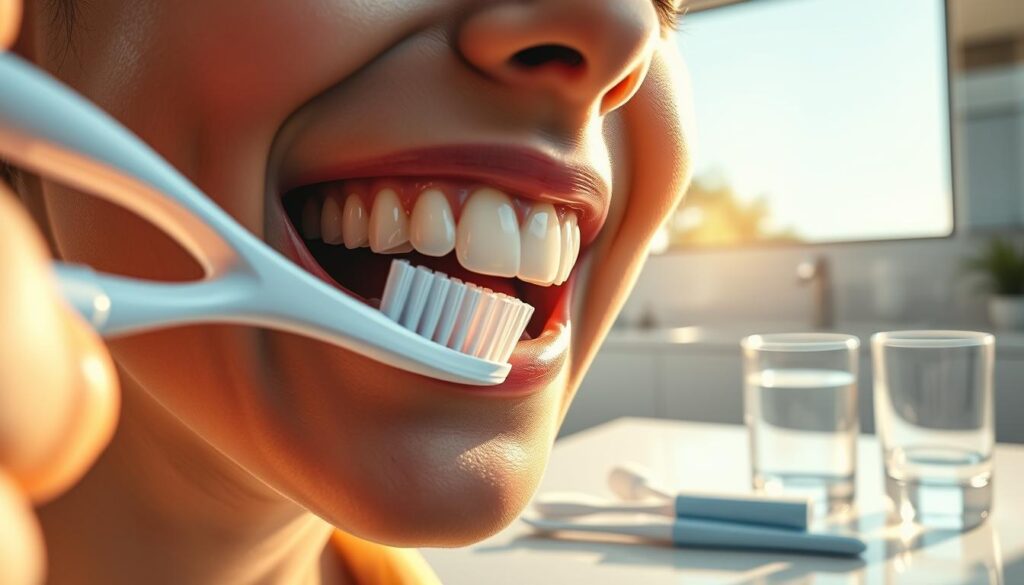
Understanding Dental Health
Preventive dentistry pushes for regular dental check-ups and daily oral health habits. Doing these regularly helps prevent tooth decay and gum disease. It teaches the importance of removing plaque to stop bacteria that cause these problems.
Consequences of Poor Hygiene
Poor oral hygiene does more than cause cavities. It can lead to serious gum diseases, which may bring other health issues like heart disease and infections. Sticking to good oral health routines greatly lowers these risks. This shows how vital regular dental care is for your overall health.
Daily Brushing Techniques
Brushing daily is key for top-notch oral health. It’s a cornerstone of smart teeth cleaning tips. It prevents dental problems and makes dentist visits easier. Using the right tools and knowing how makes this routine a strong guard against future issues.
Choosing the Right Toothbrush
Picking the right toothbrush is vital for good oral health practices. Experts recommend soft-bristled brushes because they’re gentle on gums but tough on plaque. The brush should fit your mouth, reaching the back molars with ease.
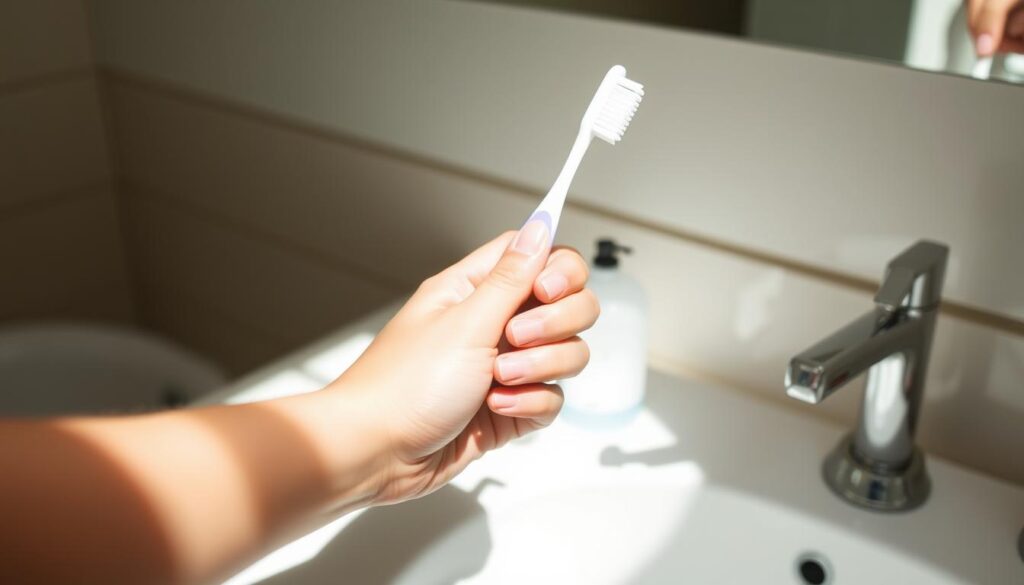
Proper Brushing Method
The way you brush matters a lot for cleaning well. Dentists say to use a soft, circular motion on all teeth surfaces. This approach cleans teeth from every direction. Brush at least two minutes, twice a day, for the best clean.
Recommended Toothpaste Types
Fluoride in toothpaste is key because it strengthens enamel and fights decay. Here’s how different toothpastes meet various needs:
| Feature | Fluoride Toothpaste | Whitening Toothpaste | Herbal Toothpaste |
|---|---|---|---|
| Primary Benefit | Cavity Protection | Stain Removal | Natural Ingredients |
| Suitable For | All Ages | Adults | Those Preferring Organic |
| Special Considerations | None | Mild Abrasives | Varies by Brand |
Selecting the best toothpaste can boost your oral hygiene at home. It’s like getting the perks of a teeth cleaning by a pro, but for your daily health.
The Role of Flossing
Flossing is key to keeping your teeth and gums healthy. It removes food and plaque that your toothbrush can’t get to. Adding flossing to your at-home dental care is important for your mouth’s health.
When to Floss
Try to floss every day, especially before bed. This stops plaque and bacteria from growing overnight. It’s a big part of keeping your mouth clean.
How to Floss Correctly
Start with 18 inches of floss. Wrap most around one finger and the rest around the opposite hand’s finger. Gently move the floss up and down between your teeth.
Curve it around the base of each tooth, making sure you go under the gumline. Use a clean part of the floss as you move to each new tooth.
Using Alternatives to Floss
If regular floss is hard to use, try other tools like water flossers or interdental brushes. Water flossers are especially good for cleaning between your teeth. They’re also great for people with braces.
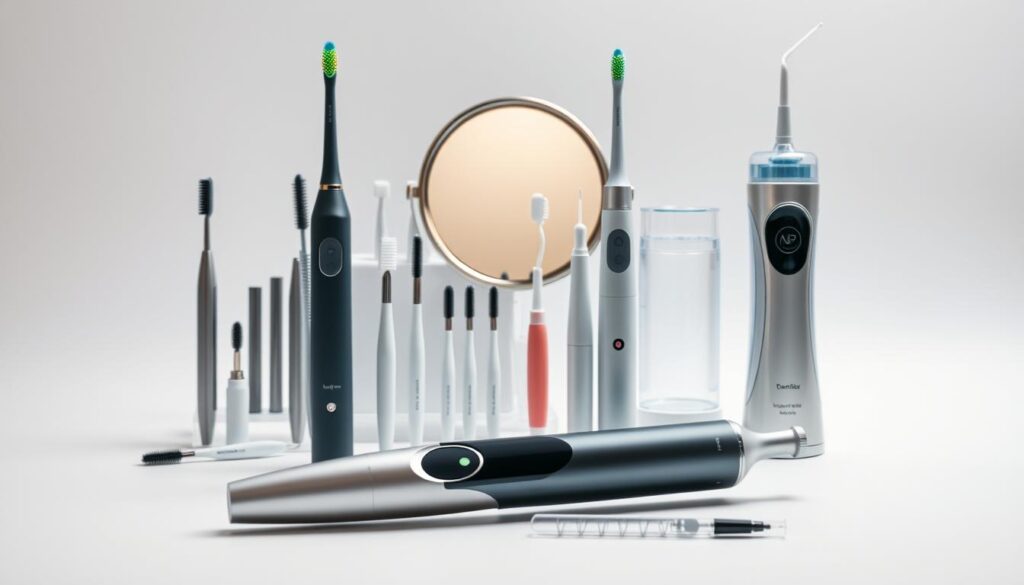
Regular flossing, with string floss or alternatives, helps clean hard-to-reach spots. This keeps your mouth healthy.
Mouthwash: Benefits and Usage
Adding mouthwash to your daily teeth cleaning routine is essential. It’s not just an extra step; it’s key for good oral health. Mouthwash helps decrease the chance of getting cavities, fights plaque, and makes your breath fresh. Combined with brushing and flossing, it greatly improves your dental health.
Types of Mouthwash to Consider
- Antibacterial Mouthwashes: Perfect for tackling bad breath and gingivitis. They have special ingredients like cetylpyridinium chloride and chlorhexidine to fight bacteria and gum disease.
- Fluoride Rinse Mouthwashes: Best for those who get cavities often. Fluoride helps restore weak tooth enamel and protects against decay.
- Natural Mouthwashes: An excellent choice for those who prefer ingredients from nature, like aloe vera and essential oils, for their antibacterial benefits.
Best Practices for Mouthwash Use
- Include mouthwash in your daily dental care, either before or after brushing.
- Gargle about 20 ml of mouthwash, making sure it reaches the back of your throat.
- Keep it in your mouth for 30 to 60 seconds before spitting, giving the active ingredients time to work.
Making mouthwash a regular part of your dental routine is key in preventing dental problems. It works with brushing and flossing to keep your dental health in top shape, ensuring a clean, fresh mouth.
Dietary Choices for Healthy Teeth
Keeping your teeth healthy is not just about brushing and flossing. It also means making smart food choices. Eating the right foods helps keep your teeth and gums strong. On the other hand, some foods can harm your dental health.
Knowing which foods to eat or avoid can really help your teeth last longer and stay healthy.
Foods to Avoid
Some foods should be eaten less to stop plaque and tooth decay. Foods with a lot of sugar and acids, like sodas, candies, and pastries, can damage the enamel on your teeth. This can lead to cavities. Also, sticky or hard foods can stick to your teeth or even break them. This allows bacteria to get in.
Foods That Promote Dental Health
It’s smart to eat foods that help clean your teeth and make enamel stronger. Crunchy fruits and vegetables like apples, carrots, and celery help make more saliva. Saliva helps to neutralize acids in your mouth and cleans food particles away. Dairy items like cheese and yogurt provide calcium and phosphates. These nutrients help make teeth stronger.

| Food Category | Benefits | Examples |
|---|---|---|
| Crunchy Fruits & Vegetables | Stimulate saliva, scrub tooth surfaces | Apples, Carrots, Celery |
| Dairy Products | Replenish calcium, strengthen enamel | Cheese, Yogurt |
| Nuts & Seeds | Provide oils that coat the teeth, reducing risk of decay | Almonds, Sunflower Seeds |
Eating the right foods and avoiding the bad ones is key for dental hygiene. It’s part of preventive dentistry. By following good oral health practices, you’re not just protecting your teeth. You’re also making your smile brighter and healthier.
Staying Hydrated
Staying hydrated is key to good oral health. It helps keep our teeth clean and our mouths healthy. Drinking enough water every day washes away food bits and bacteria. It also fights off harmful acids that can harm our teeth. Here, we’ll look at how drinking water is linked to oral health and share tips on how to drink more water.
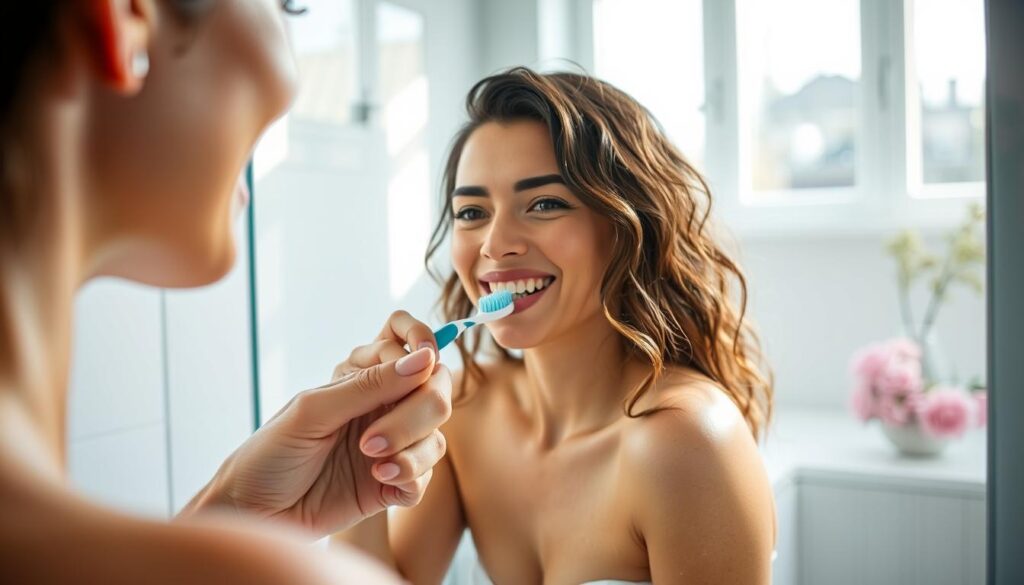
How Water Affects Oral Hygiene
Water is super important for our mouth’s health. It helps make saliva, which breaks down food and reduces mouth acidity. Drinking water often can stop plaque from forming. Plaque is sticky and full of bacteria that harm our gums and teeth. Water is better than sugary drinks because it doesn’t cause tooth decay. So, it’s a big part of keeping our mouths clean.
Tips for Increasing Water Intake
- Carry a reusable water bottle and refill it all day to always have water close by.
- Add slices of fruits like lemons or cucumbers to make your water taste better without sugar.
- Set reminders to drink more water. It helps make drinking water a regular part of taking care of your mouth.
- Start and finish your day with a glass of water to make drinking water a daily habit.
Using these tips can help keep your mouth healthy. It also helps your overall health, showing just how important water is every day.
Chewing Gum and Teeth Cleaning
Adding sugar-free gum to your daily oral health practices is a smart move for great dental hygiene. It’s an easy habit that helps keep your breath fresh and supports at-home dental care.
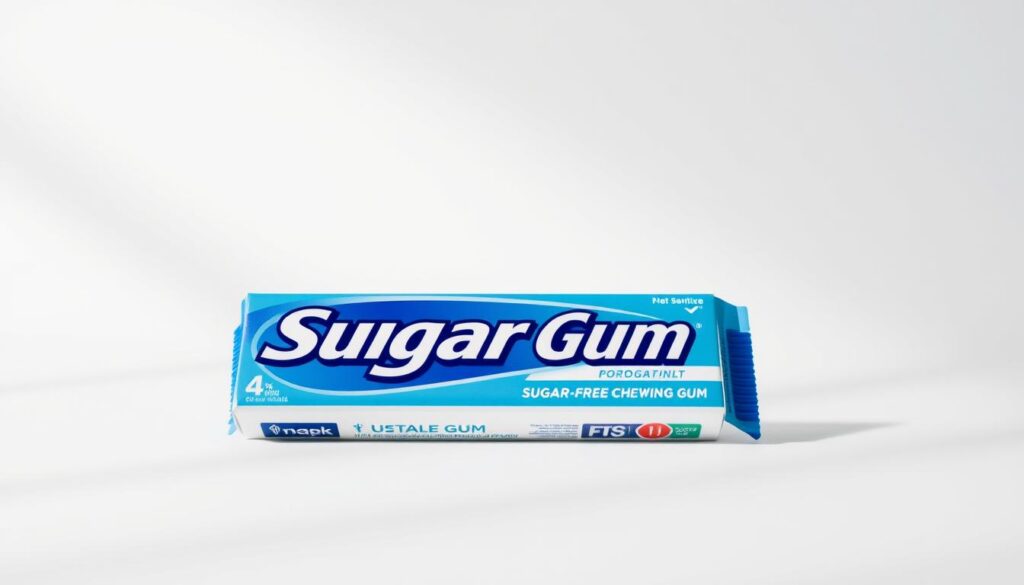
Chewing increases saliva flow, which is crucial in fighting tooth decay. Saliva fights off mouth acids and clears out food bits. This helps keep your teeth clean between meals and dentist appointments.
Benefits of Sugar-Free Gum
- Boosts saliva, which fights acids and cleans teeth.
- Stops dental erosion by making saliva better and putting back important minerals in tooth enamel.
- Offers a handy way to keep your mouth clean when you can’t brush.
When to Chew Gum
It’s best to chew sugar-free gum after meals. This habit doesn’t replace brushing and flossing. But, it’s a helpful extra step for dental hygiene when you’re out and about.
Adding sugar-free gum to your at-home dental care routine can bigly improve your oral health. It lowers the chance of getting cavities and other teeth problems. And it’s a fun, easy practice.
Regular Self-Checks
Doing regular self-checks is key for great at-home dental care. These checks make you aware of changes in your mouth that need attention before your next dental visit. Adding these checks to your prep for a dental visit greatly improves your oral care over time.
How to Perform a Dental Self-Check
- Start with clean hands and a bright mirror.
- Look for changes like discoloration or chips in your teeth.
- Check your gums for redness, swelling, or shrinking gums, pointing to possible issues.
- Search for plaque or tartar that looks rough or stained near your gums.
- Use a dental mirror to see the back of your mouth clearly.
- Lastly, watch for any lingering bad smells, hinting at bacteria or decay.
Signs of Problems to Watch For
- Sensitivity to cold, hot, or sweet could mean cavities or enamel damage.
- Look for sores, odd growths, or patches inside your mouth or on your tongue.
- Constant pain or discomfort is a warning sign for tooth or gum problems.
- Bleeding gums when you brush or floss may signal gum disease starting.
Keeping up with oral care at home by doing regular self-checks is very beneficial. It gets you ready for your dental visit and promotes a hands-on approach to your dental health. Being vigilant can stop oral diseases early and supports timely care, matching well with smart dental care practices.
The Power of Regular Dental Check-Ups
Having regular dental check-ups is critical for good oral health. These aren’t just routine visits; they’re key for preventing serious dental problems. They help keep dental hygiene at the forefront, making them an essential part of preventive dentistry.
At each visit, you get a full look at your oral care needs. Dentists do deep cleanings and check for any issues. This helps keep both your mouth and overall health in good shape.
- Your personal health, dental history, and lifestyle determine how often you should see your dentist.
- Experts often suggest a check-up every six months to catch any problems early.
- But, if you have certain dental conditions, you might need to go more often.
What to Expect During an Appointment
- You’ll talk about your dental and medical history, including new health issues or medicines.
- A professional cleaning removes plaque and tartar to help prevent decay and gum disease.
- They’ll check your teeth, gums, and mouth for any signs of trouble.
- You’ll discuss what they find and plan any needed follow-up visits or treatments.
Knowing how often to visit and what happens at each appointment can really boost your oral care routine. This sets the stage for healthy teeth for years to come.
Protective Dental Gear
Keeping your teeth healthy is more than just brushing and flossing every day. It also means protecting your teeth from harm. Mouthguards are key in preventing injuries, especially during sports. It’s important to talk to your dentist about the best dental protection for you.
Why Use Mouthguards?
Mouthguards are vital for keeping teeth safe. They are a must for anyone playing contact sports like football or hockey, and also for those in non-contact activities like skateboarding. Wearing a mouthguard can prevent broken teeth, dislocations, and loss of teeth. They’re advised for athletes of every age to protect their teeth.
Choosing the Right Mouthguard
It’s important to pick the right mouthguard for both safety and comfort. There are three kinds:
- Stock mouthguards: These are ready to use but offer the least protection since you can’t adjust their size.
- Boil-and-bite mouthguards: These are made from a material that softens in hot water. You can then shape them to fit your mouth.
- Custom-fitted mouthguards: These are made by a dentist from a mold of your teeth. They offer the best protection but cost more.
Talking to a dental expert is crucial when picking a mouthguard. They can help find the right one based on your activities and dental needs.
Managing Bad Breath
Halitosis, or bad breath, is a widespread issue. It can shake your confidence and show how well you take care of your teeth at home. Knowing why it happens and using home tricks are key to keeping your mouth clean.
Many things can cause bad breath, from what you eat to bigger health concerns tied to your mouth care. To handle it well, mix regular dentist visits with good daily mouth care habits. For tips on how dentist visits can fight bad breath, check out professional dental cleaning services.
- Food left in your mouth
- Plaque and weak gum health
- Having a dry mouth
- Using tobacco or drinking alcohol
Home Remedies to Freshen Breath
- Brush and floss often to get rid of food bits and plaque.
- Scrape your tongue every day.
- Drink more water to wash away food and germs.
- Chew sugar-free gum to make more saliva, which cleans your mouth.
- Add mouthwash to your daily routine to kill smell-causing bacteria.
By following these at-home dental care tips, you can control bad breath and keep your mouth healthy. Staying on top of your care is key to having fresh breath and great oral hygiene.
Using Dental Tools at Home
Looking into dental tools for home can make your daily care better. It also greatly helps your dental hygiene. When you pick between manual or electric toothbrushes, think about what works best for your teeth cleaning tips.
Electric toothbrushes are better at removing plaque than manual ones. Experts often suggest them for their consistent cleaning and special features. What to Expect during a Dental shows how these tools help keep your mouth clean between dentist visits. But, some folks still like manual toothbrushes for their simplicity and control.
Also, water flossers are becoming a favorite choice for a soft yet thorough clean between teeth. They are super helpful for those with braces or other dental stuff in their mouths.
| Feature | Electric Toothbrush | Manual Toothbrush |
|---|---|---|
| Efficacy | Higher | Moderate |
| Cost | Higher | Lower |
| Usability | User-friendly | Requires Technique |
| Accessibility | Readily available | Universally accessible |
When picking dental tools for home, think about what you find comfy. Also, consider if it fits into your daily care routine easily. And don’t forget to listen to what dental pros recommend. This way, you can choose the best tool for your dental hygiene.
Children’s Dental Care
Teaching kids to take care of their teeth early is key in preventive dentistry. It helps keep their teeth healthy for a long time. By showing kids how to take care of their teeth, we build a foundation for good dental health in the future.
Teaching Kids Good Habits
Teaching kids how to brush and floss right is crucial for keeping their teeth clean. It’s important to watch them until they can do it on their own. Make sure they use just a little toothpaste and brush for two minutes.
Fun Ways to Promote Oral Health
Making dental care fun can really make kids want to keep their teeth clean. For example, singing a song while brushing or making it a game can make them enjoy it. This way, they’re more likely to remember to brush and floss every day.
Creating a fun chart to track their brushing or giving them small rewards for good dental health can make a big difference. This helps kids feel good about taking care of their teeth. As they grow, they’ll keep these healthy habits for life.
| Age | Recommended Brushing Technique | Fun Activity |
|---|---|---|
| 2-4 Years | Gentle Circles | Brush to the Beat |
| 5-7 Years | Brush Back and Front of Teeth | Colorful Brushing Charts |
| 8-10 Years | Two Minute Time Rule | Interactive Dental Apps |
Handling Dental Emergencies
In oral care, quick and smart moves are key when faced with dental emergencies. These issues can come out of nowhere and cover many situations, like sudden toothaches or major injuries to the teeth. Knowing how to handle these emergencies and when to get help from a dentist can prevent long-term problems. This knowledge is crucial for your immediate comfort and overall oral health.
Dental emergencies can include several urgent dental problems. Severe infections, such as abscesses, can bring a lot of pain and swelling. Also, physical injuries can lead to broken or knocked-out teeth that need quick action to fix. When these problems happen, it’s important to remember what to do, like calling your dentist right away or using first aid to lessen pain or stop bleeding.
It’s vital to know when you must seek urgent dental help. While a slightly sensitive tooth might not be an emergency, severe pain, a lot of bleeding, or a loose tooth are signs you need to see a dentist fast. Acting quickly can stop more damage and improve your chances of getting better. So, it’s very important to be alert and ready to deal with dental emergencies efficiently.


